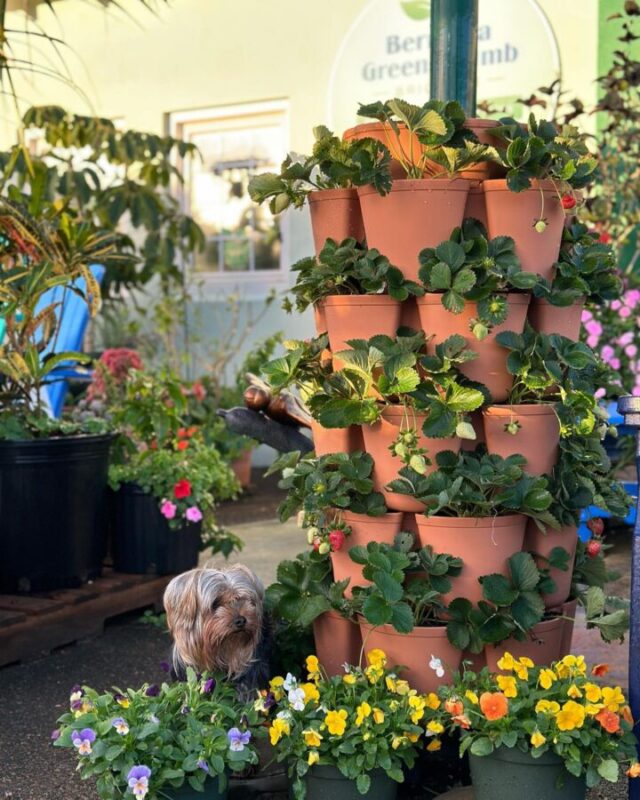If you have ever wanted to grow your own organic vegetables but lack the time or energy to till the soil, then container gardening might be the ideal solution for you.
Container gardening has numerous advantages over a traditional garden plot as it allows plants to be cultivated in just about any sheltered spot that gets morning sunlight including balconies, and patios, and can be as simple as a few herbs in repurposed yogurt cups on your kitchen windowsill or a complex array of stacking planters yielding enough fresh produce to meet the needs of an entire family.
Regardless of whether you are a complete novice or an experienced green thumb, the initial question beyond what do you want to grow quickly becomes – how do you choose the right containers to meet your needs?
 Eugene O’Connor, Co-Owner of Bermuda Green Thumb (a Division of the Bermuda Florist Limited), says that as a rule you can grow shallow root vegetables such as herbs and leafy salad vegetables in just about any container with adequate drainage. When it comes to carrots and potatoes however, “it is all about depth because their root system requires 10-12 inches of soil.”
Eugene O’Connor, Co-Owner of Bermuda Green Thumb (a Division of the Bermuda Florist Limited), says that as a rule you can grow shallow root vegetables such as herbs and leafy salad vegetables in just about any container with adequate drainage. When it comes to carrots and potatoes however, “it is all about depth because their root system requires 10-12 inches of soil.”
Bermuda Green Thumb stocks a wide range of horizontal and vertical containers guaranteed to suit every landscape and aesthetic situation, and each comes with its own list of pros and cons – terra-cotta pots for example may be aesthetically pleasing, but they also dry out quickly in Bermuda’s steamy summer weather and will require constant watering.
“If you are older or want to avoid back breaking digging, you could opt for a waist-high raised bed container,” says Mr. O’Connor. “We even have some with wheels so that they can be moved inside in bad weather and then placed back out when the storm is over.”
Containers also offer greater control over soil conditions, enabling gardeners to tailor the soil mix to suit specific plant needs, ensuring better drainage and aeration; and they also make it easy to supplement your soil with organic fertilizer or aged compost to achieve a good yield.
“If your raised bed is particularly large, however, you can fill the bottom half with a mixture of dry branches and other aged forest plant material. This has the advantage of cutting down on the overall weight of the container and the cost of potting mix,” he explains.
How do you find the ideal location for your container?
Regardless of the type of container that you opt for, Mr. Aaron Furbert, who operates Furbert’s Vertical Gardening, also recommends choosing a spot that gets plenty of sunlight that is also sheltered from strong prevailing wind. He specializes in fabricating vertical garden structures which are fashioned from recycled plastic drums making them very durable.
“Vertical gardening is a good way to grow plants in abundance in a small area that would not normally be able to accommodate many plants,” he says. “These containers lift the plants off the ground making them less susceptible to pests and also need less watering because very little of the soil surface area is exposed.”
While you can grow just about anything except for pumpkin and watermelon in a vertical tower, Mr. Furbert recommends plants from the brassica plant family. “Things like lettuce, kale, mustard greens, and arugula do particularly well in vertical towers, as do small flowering plants such as marigolds,” he explained.
How do you decide whether to install a vertical garden or a raised bed?
When deciding between installing a vertical garden or a raised bed, it is important to start by considering where you want to place your garden unit.
Vertical gardens which can grow between 30-120 plants in a single unit (depending on the model that you choose) are ideal for smaller areas, making them an excellent choice for balconies or limited yard space, while raised beds are an excellent choice for larger gardens with access to plenty of sunlight. They also have the advantage of being constructed (or configured) to just about any size and shape.
It is also important to consider the soil requirements of the type of plants you wish to cultivate, as some may thrive better in vertical arrangements, while others may prefer the depth and soil volume of raised beds.
Finally, think about maintenance preferences and accessibility, as raised beds are generally easier to reach and tend to, while vertical gardens may need to be rotated regularly to ensure that plants develop evenly due to their vertical orientation.
And if this all seems like a bit too much effort, Mr. Furbert can also provide organic seedlings and a customized maintenance program to meet individual needs.
Looking to dust off your carpentry skills and start container gardening on a budget?
Why not construct a raised vegetable bed from reclaimed wood?
• Begin by selecting a suitable location with ample sunlight and access to water.
• Outline the bed’s dimensions with sticks and string and then clear the area of grass and weeds.
• Next, construct a wooden frame using recycled lumber cut to the appropriate lengths, and secure the corners with screws or bolts. Keep in mind that you will most likely need at least two rows of boards to achieve a soil depth of 10-12 inches.
• Line the bottom with cardboard or landscaping fabric to discourage weeds from growing up into the bed and then fill the bed with a high-quality soil mix, combining equal parts of garden soil, compost, and peat moss or coconut fibre for good drainage and nutrient retention.
• Be sure to level the soil and water it thoroughly before planting.
• Plant with the veggies of your choice and water as needed.
Whatever your circumstances, container gardening offers flexibility in plant selection and empowers individuals to create beautiful, functional gardens while overcoming space limitations and enhancing gardening success.
For more information contact:
Eugene O’Connor – Bermuda Green Thumb 236-5862
Aaron Furbert – Furbert’s Vertical Gardening 777-8125

